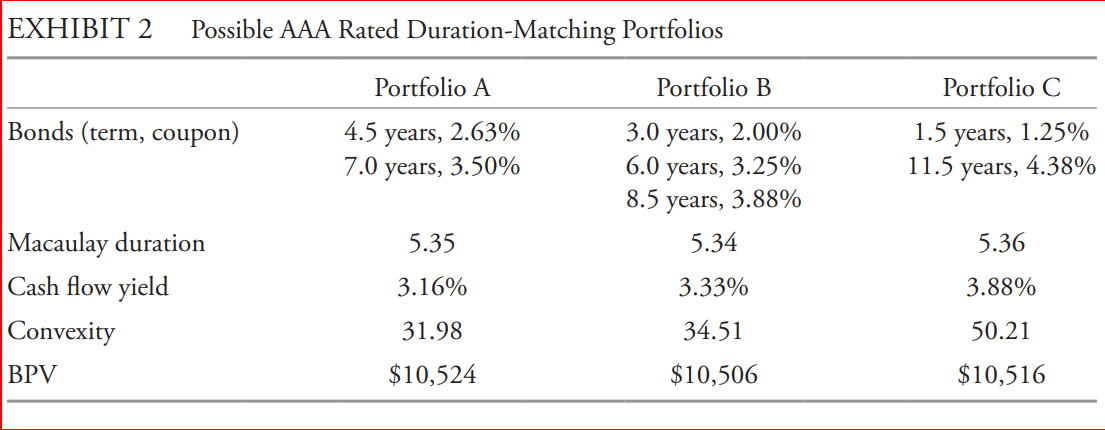The following information relates to Questions
Serena Soto is a risk management specialist with Liability Protection advisors. trey hudgens, CFo of Kiest Manufacturing, enlists Soto's help with three projects. The first project is to defease some of Kiest's existing fixed-rate bonds that are maturing in each of the next three years. The bonds have no call or put provisions and pay interest annually. exhibit 1 presents the payment schedule for the bonds.
EXHIBIT 1 Kiest Manufacturing Bond Payment Schedule as of 1 October 2017
The second project for Soto is to help hudgens immunize a $20 million portfolio of liabilities. The liabilities range from 3.00 years to 8.50 years with a Macaulay duration of 5.34 years, cash flow yield of 3.25%, portfolio convexity of 33.05, and basis point value (bPv) of $10,505. Soto suggested employing a duration-matching strategy using one of the three aaa rated bond portfolios presented in exhibit 2.
 Soto explains to hudgens that the underlying duration-matching strategy is based on the
Soto explains to hudgens that the underlying duration-matching strategy is based on the
following three assumptions.
1. yield curve shifts in the future will be parallel.
2. bond types and quality will closely match those of the liabilities.
3. The portfolio will be rebalanced by buying or selling bonds rather than using derivatives.
The third project for Soto is to make a significant direct investment in broadly diversified global bonds for Kiest's pension plan. Kiest has a young workforce, and thus, the plan has a long-term investment horizon. hudgens needs Soto's help to select a benchmark index that is appropriate for Kiest's young workforce and avoids the "bums" problem. Soto discusses three benchmark candidates, presented in exhibit 3.
 With the benchmark selected, hudgens provides guidelines to Soto directing her to (1)
With the benchmark selected, hudgens provides guidelines to Soto directing her to (1)
use the most cost-effective method to track the benchmark and (2) provide low tracking error.after providing hudgens with advice on direct investment, Soto offered him additional information on alternative indirect investment strategies using (1) bond mutual funds, (2)
exchange-traded funds (etFs) , and (3) total return swaps. hudgens expresses interest in using bond mutual funds rather than the other strategies for the following reasons.
reason 1 total return swaps have much higher transaction costs and initial cash outlay than bond mutual funds.reason 2 Unlike bond mutual funds, bond etFs can trade at discounts to their underlying indexes, and those discounts can persist.reason 3 bond mutual funds can be traded throughout the day at the net asset value of the underlying bonds.
-based on exhibit 2, relative to Portfolio C, Portfolio b:
Definitions:
Hypotheses
Plural of hypothesis, referring to multiple proposed explanations made as starting points for further investigation, which can be tested through research and experimentation.
Empirical Reasoning
The process of deriving logical conclusions from verifiable evidence through observation and experimentation.
Predict Phenomena
The act of forecasting or making predictions about future events based on current or past data.
Empirical Inquiry
The method of seeking knowledge through observation, experimentation, and empirical evidence rather than through theory or pure logic.
Q1: A drive shaft running at 2500 rpm
Q13: A thin-walled spherical tank has a
Q21: Write the complex conjugate of the
Q24: during the presentation about how the research
Q28: Find the exact value of the
Q39: An investor considers the purchase of
Q40: Use the Law of Sines to
Q57: Use a calculator to evaluate the
Q73: Select the graph of the polar
Q177: <span class="ql-formula" data-value="\text { Find a number